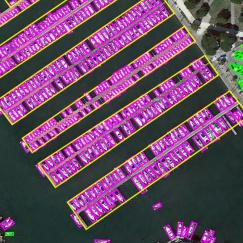On the Arbitrary-Oriented Object Detection: Classification based Approaches Revisited
Arbitrary-oriented object detection has been a building block for rotation sensitive tasks. We first show that the boundary problem suffered in existing dominant regression-based rotation detectors, is caused by angular periodicity or corner ordering, according to the parameterization protocol. We also show that the root cause is that the ideal predictions can be out of the defined range. Accordingly, we transform the angular prediction task from a regression problem to a classification one. For the resulting circularly distributed angle classification problem, we first devise a Circular Smooth Label technique to handle the periodicity of angle and increase the error tolerance to adjacent angles. To reduce the excessive model parameters by Circular Smooth Label, we further design a Densely Coded Labels, which greatly reduces the length of the encoding. Finally, we further develop an object heading detection module, which can be useful when the exact heading orientation information is needed e.g. for ship and plane heading detection. We release our OHD-SJTU dataset and OHDet detector for heading detection. Extensive experimental results on three large-scale public datasets for aerial images i.e. DOTA, HRSC2016, OHD-SJTU, and face dataset FDDB, as well as scene text dataset ICDAR2015 and MLT, show the effectiveness of our approach.
PDF Abstract ECCV 2020 PDF ECCV 2020 AbstractCode
Results from the Paper
 Ranked #37 on
Object Detection In Aerial Images
on DOTA
(using extra training data)
Ranked #37 on
Object Detection In Aerial Images
on DOTA
(using extra training data)
| Task | Dataset | Model | Metric Name | Metric Value | Global Rank | Uses Extra Training Data |
Benchmark |
|---|---|---|---|---|---|---|---|
| Object Detection In Aerial Images | DOTA | CSL | mAP | 76.17% | # 37 |








 ssd
ssd
 DOTA
DOTA
 FDDB
FDDB